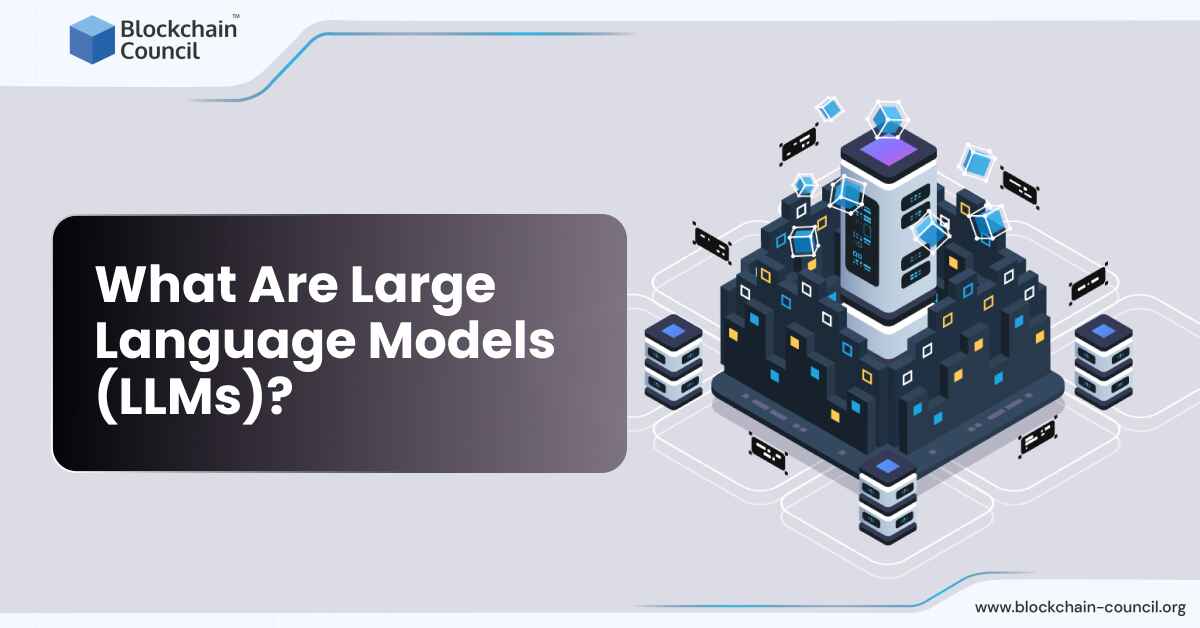
- Blockchain Council
- October 21, 2024
Curious about the technology behind chatbots and virtual assistants? Large Language Models (LLMs) are the brains powering these tools. They understand and generate human-like text, making interactions smooth and intuitive.
What Are LLMs?
Large Language Models (LLMs) are advanced artificial intelligence systems designed to understand and generate human-like text. They achieve this by being trained on vast amounts of text data, enabling them to predict and generate coherent sentences and responses based on the input they receive. Examples of LLMs include GPT-4, BERT, and LLaMA. These models can assist in various tasks such as writing, coding, translating languages, and even creating conversational agents like chatbots.
How Large Language Models Work
LLMs work by processing text through a series of steps involving tokenization, encoding, and attention mechanisms.
- Tokenization: The first step is breaking down text into smaller units called tokens. Tokens can be words, subwords, or characters. This process allows the model to handle text in manageable pieces.
- Encoding Positions: Since word order matters in understanding language, LLMs use positional encoding to keep track of the position of each token within the input text. This helps the model understand the context and structure of the text.
- Attention Mechanisms: LLMs utilize attention mechanisms to focus on relevant parts of the input text while processing it. This ensures that the model gives more importance to significant words and phrases, improving the accuracy of its responses. Self-attention and cross-attention are common types used in these models.
- Training: During training, LLMs learn patterns in the text data by adjusting their internal parameters. This involves multiple layers of processing, where each layer refines the model’s understanding and ability to generate text. Techniques like supervised learning, reinforcement learning from human feedback (RLHF), and fine-tuning with specific datasets are often used.
- Generation: Once trained, LLMs can generate text by predicting the next token in a sequence, given an initial input. This allows them to produce responses that are contextually appropriate and linguistically coherent.
LLMs and Governance
Governance of large language models (LLMs) involves addressing several crucial areas to ensure their safe and ethical use. Recent discussions and policies underline the importance of creating governance frameworks that promote transparency, accountability, and the enforcement of privacy and security standards. It is essential for organizations to determine who is responsible for managing LLM governance strategies and bring together key stakeholders from AI engineering and security teams. The goal is to agree on prerequisites for an AI governance framework, which may include implementing full monitoring of LLM deployments to identify and mitigate risks such as data leaks or adversarial attacks.
The UK has initiated inquiries to explore the future landscape of LLMs and to decide on appropriate regulatory approaches. These inquiries aim to address potential disruptions by establishing better safeguards and regulatory standards that promote innovation while managing risks. They also explore the need for clear guidelines on power dynamics as LLMs become more integrated into business and personal lives.
Companies like Microsoft have introduced features like “Content Safety” and “Prompt Shields” to monitor and filter model outputs, mitigating risks such as data leaks and unauthorized access.
What Are the Different Types of Large Language Models?
Large Language Models (LLMs) vary in their architecture and use cases. Here’s a quick overview of the main types:
- General Purpose LLMs: These models, such as GPT-4 and OpenAI’s series, are versatile and can handle a broad range of tasks from text generation to translation. They are trained on diverse datasets and can be fine-tuned for specific applications.
- Specialized LLMs: Models like GitHub Copilot are designed for specific domains, such as coding or technical writing. These models are fine-tuned with domain-specific data, making them more accurate in their targeted tasks.
- Multimodal LLMs: These models, like GPT-4 Turbo with Vision, can process and generate text, images, and other data types, enabling applications that require a combination of different media.
- Open Source LLMs: Models like LLama 3 and Falcon 40B are developed by the open-source community. They offer transparency and flexibility, allowing users to customize and deploy the models according to their needs without licensing restrictions.
- Small Language Models (SLMs): These are scaled-down versions of LLMs, designed for resource-constrained environments. They offer cost-effective solutions for businesses that need efficient and quick inferencing capabilities on edge devices or in offline settings.
- Zero Shot Models: Zero-shot models are types of AI that can tackle new tasks without prior specific training, using learned general principles to adapt to challenges they haven’t seen during training.
Examples of LLMs
- GPT-4: Developed by OpenAI, GPT-4 is notable for its broad capabilities in reasoning, language understanding, and generating human-like text.
- Claude 3: Created by Anthropic, Claude 3 is a model designed for a variety of tasks including advanced reasoning and large-scale language comprehension.
- LLaMA 3: Meta AI’s LLaMA 3 offers high performance at a lower cost, making it accessible for both personal and commercial uses.
- Gemini 1.5: Google’s model, notable for its ability to process extremely large inputs and support real-time applications.
- Falcon 180B: This model from the UAE-based Technology Innovation Institute stands out for its multilingual capabilities and strong performance on natural language tasks.
LLM Use Cases
LLMs are versatile and can be applied in various fields:
- Customer Support: LLMs can manage customer inquiries, providing quick and accurate responses, reducing the need for human customer service representatives.
- Content Creation: From writing articles to composing emails, LLMs help in generating text that is coherent and contextually appropriate.
- Education and Training: LLMs assist in educational settings by providing tutoring or creating personalized learning materials.
- Language Translation: They excel in translating languages, making global communication smoother and more efficient.
- Coding and Software Development: Tools like GitHub Copilot and Codet5 help developers by providing code completion, bug fixes, and even generating code from scratch.
- Language Translation: With their deep learning capabilities, LLMs excel in understanding and translating multiple languages, making global communication smoother.
- Data Analysis and Insights: LLMs can analyze large volumes of text data to extract useful insights and summaries.
Why Are LLMs Becoming Important to Businesses?
LLMs are becoming crucial for businesses due to several key reasons:
- Efficiency: Automating routine tasks and processes, allowing employees to focus on more strategic activities.
- Cost Reduction: Lowering the need for extensive human intervention in areas like customer service and data analysis.
- Scalability: Enabling businesses to handle larger volumes of work without proportional increases in cost or effort.
- Innovation: Driving new product development and services, such as personalized marketing and advanced data insights.
- Competitive Advantage: Providing capabilities that can differentiate businesses in the market, such as improved customer experiences and faster decision-making.
What Are the Advantages of Large Language Models?
- Versatile Applications: Large language models (LLMs) excel in various tasks such as natural language processing (NLP), translation, summarization, and content creation. They can generate human-like text, making them valuable for chatbots, virtual assistants, and content creation tools.
- Improved Accuracy and Reasoning: Advanced models like GPT-4 have shown significant improvements in reasoning and logical thinking. They provide more accurate and contextually relevant responses, enhancing user experience in applications such as customer support and coding assistance.
- Scalability and Customization: LLMs are scalable and can be fine-tuned for specific applications. This allows businesses to customize models according to their needs, improving efficiency and relevance in various use cases, from automated documentation to complex problem-solving.
- Enhanced Creativity: These models can assist in creative tasks like story writing, game design, and brainstorming, providing novel ideas and perspectives that can inspire human creativity and innovation.
What Are the Challenges and Limitations of Large Language Models?
- High Computational Costs: Training and deploying LLMs require substantial computational resources, making them expensive to develop and maintain. This can be a barrier for smaller companies or research institutions.
- Bias and Ethical Concerns: LLMs can inherit biases from the data they are trained on, leading to ethical concerns regarding fairness and accuracy. Addressing these biases requires ongoing efforts to improve training data and model transparency.
- Data Privacy Risks: LLMs may expose sensitive data, especially if they are not properly managed or if they inadvertently generate or recall private information. Ensuring data privacy and security is crucial when using these models in sensitive applications.
- Inaccuracies and “Hallucinations”: Despite their capabilities, LLMs can generate false or misleading information, known as “hallucinations”. This limits their reliability in tasks requiring high accuracy and factual correctness.
The Future of Large Language Models
The future of large language models (LLMs) is shifting towards more efficient and specialized applications. While large models like ChatGPT and GPT-4 have shown impressive capabilities, they are costly and resource-intensive to develop and maintain. This has led to a growing interest in smaller, more focused models that can perform specific tasks efficiently.
One significant trend is the development of small language models (SLMs), which require fewer resources and can be tailored to specific tasks. These models are not only more cost-effective but also offer better performance for targeted applications. For example, Microsoft’s PHI-2, with 2.7 billion parameters, outperforms much larger models in several tasks by using high-quality training data and innovative scaling techniques.
Another important development is the rise of open-source LLMs. Open-source models provide benefits such as enhanced data security, privacy, and community collaboration.
In the business world, smaller models are increasingly being used internally to handle proprietary data securely. These models can be customized for specific corporate needs without exposing sensitive information to public models. This approach not only reduces costs but also improves accuracy by focusing on relevant data.
Looking ahead, the integration of LLMs with technologies like IoT and cybersecurity will drive further innovation. We can expect these models to enhance productivity and efficiency across various industries, supporting more human-AI collaboration and even reshaping the workforce.
Conclusion
Large Language Models have transformed how we interact with technology. From improving customer service to aiding in content creation, their impact is far-reaching. Understanding the basics of LLMs helps appreciate their role in our daily digital experiences. As technology evolves, LLMs will continue to shape the future, making our interactions with machines more natural and efficient.
FAQs – Large Language Models (LLMs)
What are Large Language Models (LLMs)?
- LLMs are advanced AI systems designed to understand and generate human-like text.
- They are trained on vast amounts of text data.
- Examples include GPT-4, BERT, and LLaMA.
- They assist in tasks like writing, coding, translating languages, and creating chatbots.
How do Large Language Models work?
- Tokenization: Breaking down text into smaller units called tokens.
- Encoding Positions: Keeping track of the position of each token in the text.
- Attention Mechanisms: Focusing on relevant parts of the input text.
- Training: Learning patterns by adjusting internal parameters.
- Generation: Predicting the next token in a sequence to generate coherent text.
What are the uses of Large Language Models?
- Customer Support: Managing inquiries and providing quick responses.
- Content Creation: Writing articles, emails, and other text.
- Education: Tutoring and creating personalized learning materials.
- Language Translation: Translating languages for smoother global communication.
- Coding Assistance: Helping developers with code completion and bug fixes.
What are the challenges of Large Language Models?
- High Computational Costs: Requires significant resources to train and maintain.
- Bias and Ethical Concerns: Potential for inheriting biases from training data.
- Data Privacy Risks: Possibility of exposing sensitive data.
- Inaccuracies: Can generate false or misleading information, known as “hallucinations.”





































































 Guides
Guides News
News Blockchain
Blockchain Cryptocurrency
& Digital Assets
Cryptocurrency
& Digital Assets Web3
Web3 Metaverse & NFTs
Metaverse & NFTs
